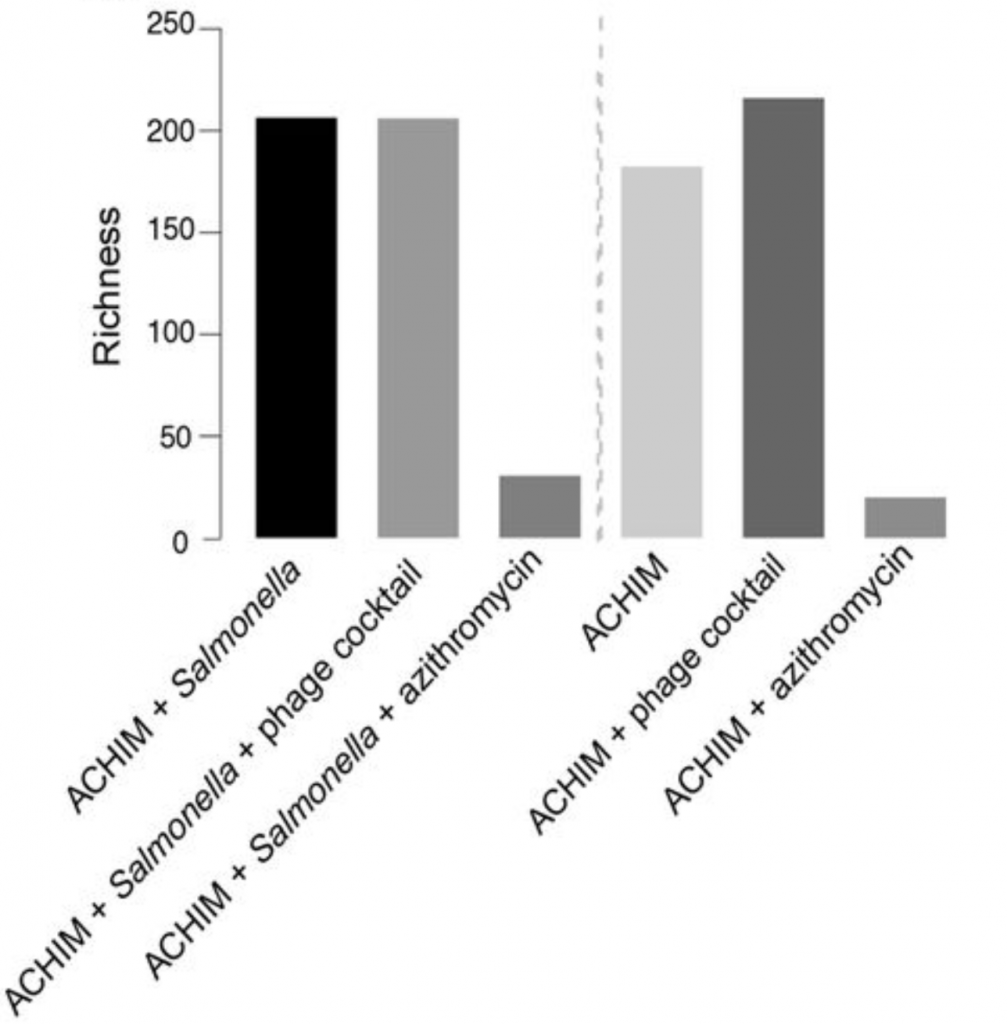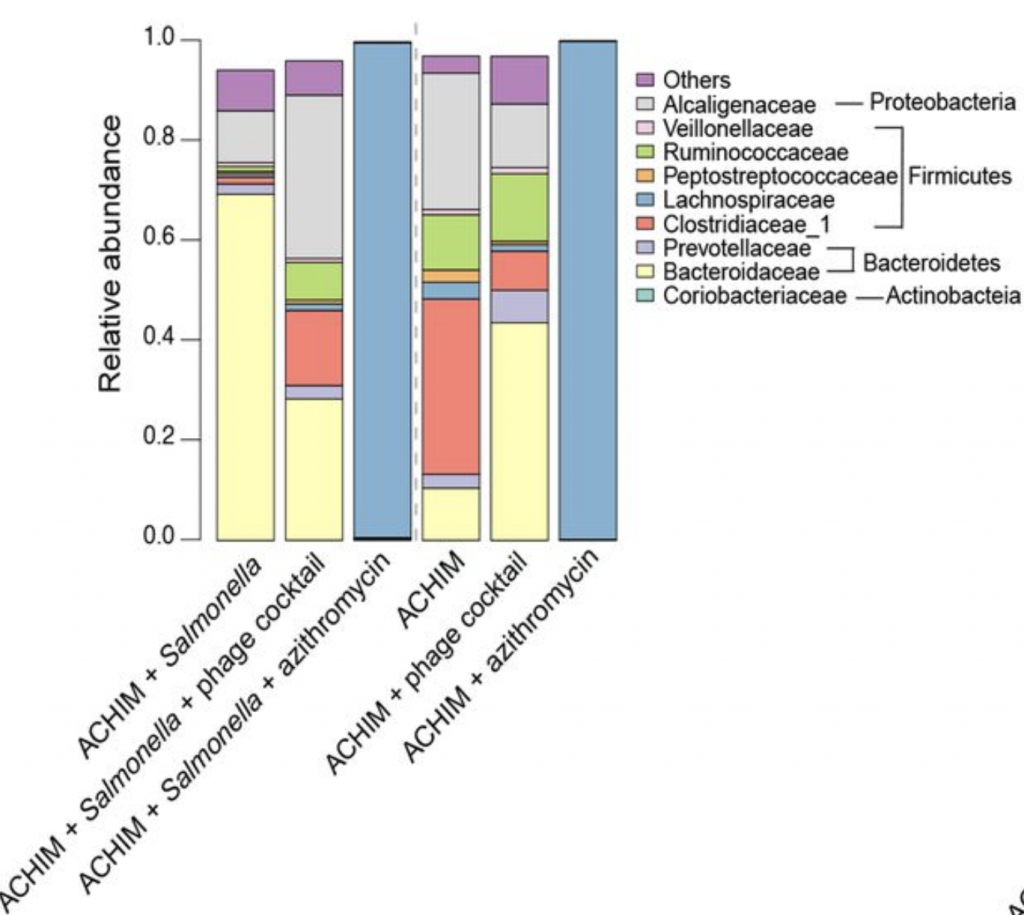 Salmonella up close (Food Safety News)
Salmonella up close (Food Safety News)BACKGROUND
Salmonella are bacteria that are often responsible for food-borne illnesses. The symptoms of Salmonella infection is “nausea, vomiting, abdominal cramps, diarrhea, fever, chills, headache, and blood in stool’ (Mayo Clinic, 2019). Sometimes Salmonella infections need to be treated with antibiotics, but it is becoming more common that Salmonella and other infectious bacteria are antibiotic resistant due to overexposure to antibiotics (Centers for Disease Control and Prevention, 2019). When someone with an antibiotic resistant bacteria gets sick, it can be incredibly difficult to treat if the person’s immune system isn’t able to fight off the illness on its own. However, there’s an alternative, bacteriophages are viruses that infect and kill specific bacteria or archaea. This treatment option has gained interest in the last decade due to the increasing abundance of antibiotic resistant bacteria.
The way bacteriophages work is by infecting specific bacteria or archaea and taking over the bacteria’s cell machinery in order to replicate (Sulakvelidze et al., 2001). The viruses then break out of the cell and go off to infect other bacteria. The exciting thing about bacteriophages is that they are very specific in which bacteria they infect. There are Salmonella-specific bacteriophages that only infect Salmonella bacterial species and spare other kinds of bacteria in the surrounding environment. This idea of treating bacterial infections is termed as “phage-therapy’ (Ho Yue et al., 2014). Phage-therapy comes of great importance when maintaining the integrity of the huge abundance and diversity of bacteria that constitutes a healthy gut.

In this study, the scientists ran experiments on fresh human stool donated from a healthy Scandinavian. They refrained from using bacteriophages on humans because the use of bacteriophages on living this still widely unknown. Using stool sample allows scientists to test different treatments without causing adverse effects upon the person donating the sample. They ran the experiments over the span of 7 days to monitor the results.
CENTRAL QUESTION:
Can phage-therapy be used in place of using an antibiotic to treat Salmonella infection ?
THE EVIDENCE
They were able to see the change in bacterial presence by culturing the Salmonella and visually monitoring the presence over a seven day period. They also used a microscope and fluorescent markers to count live and dead ones over time. To determine the differences seen, the researchers primarily focused on 3 treatments: Salmonella with the healthy stool sample, Salmonella with the stool and bacteriophages, and then the Salmonella with the stool and the antibiotic. Towards the end of the 7 days, there was a significant drop in the presence of Salmonella in all treatments, suggesting that the healthy stool sample has existing ready-to-go defenses against the bad bacteria without help from viruses or medicine.
They found that the bacteriophages, AKA “phage cocktail’, worked very specifically to kill the Salmonella present and left the rest of the bacteria that is naturally present in the stool to grow into more more even proportions in the Salmonella, stool, and bacteriophage treatment (Figure 1). They were able to see this by taking samples of DNA and looking at a gene called 16S to determine what bacteria were present at a given time.


The very first day they noticed a significant drop in both the Salmonella and the healthy bacteria when azithromycin was used. Almost all of the bacteria had died toward the end of the azithromycin treatment (Figure 1). They also noticed a significant decrease in diversity among the bacteria present in the stool, also known as ACHIM, by viewing the bacteria present when looking at the 16S genes of all the bacteria in the culture (Figure 2).
In summary, the stool has the ability to fight off Salmonella on its own, but if it is not able to, phage-therapy could be a good alternative to treat the infection rather than using azithromycin in order to preserve the microbial integrity of the gut.
MY QUESTIONS
- What are the effects of bacteriophages on the immune system? Could the bacteriophages trigger an immune response like other viruses do?
- How expensive is phage therapy in comparison to antibiotic treatments to treat antibiotic resistant bacteria?
- What is the likelihood that the bacteria and/or virus mutate making the bacteriophage no longer able to attack Salmonella?
- Is there a chance bacteriophages can mutate and go after normal healthy bacteria from our microbiome?
- If someone is exposed to a certain bacteriophage once, can they use the same bacteriophage again without the immune system destroying the virus, somewhat how vaccinations work?
- Why do bacteriophages give the opportunity for the human gut microbiome to become more diverse?
FUTURE RESEARCH IDEAS
It would be interesting to study people from countries that already use phage-therapy, such as in Russia or Europe, as treatment against bacterial infections. Understanding how phage-therapy reacts with the immune system and the microbiome inside human hosts could be very beneficial to address the antibiotic crisis occurring world-wide.
Perhaps subjects that have no other option for treatment can be treated with phage therapy when it is life or death. If antibiotics are not working as they should, because the bacteria are resistant to the antibiotic mechanisms, phage therapy could possibly be a better alternative that could save someone’s life.
FURTHER READING
The link listed below is the study discussed in this blog. It goes into the scientific literature that explains this blog post more elaborately. Bacteriophages Synergize with the Gut Microbial Community To Combat Salmonella – Hu Yue, et al. 2018.
This link provides a story of a man who became severely ill due to developing an infection that was caused by a multi-resistant antibiotic bacteria. The bacteria causing his illness was resistant to all available antibiotics and he was in critical condition. The man entered into a coma for months then the doctors got approval to try phage therapy against the bacteria. The man woke up from his coma and beat the infection that almost brought on his death. Novel Phage Therapy Saves Patient with Multidrug-Resistant Bacterial Infection – April 25, 2017 | Scott LaFee and Heather Buschman, PhD
If you’re not into reading but managed to get through this blog, here is an informational video on phage-therapy from YouTube. Phage Therapy: An Effective Alternative to Antibiotics? 2017.
REFERENCES
- Alexander Sulakvelidze, Zemphira Alavidze, and J. Glenn Morris, Jr. (2001). Antimicrobial Agents and Chemotherapy 45(3): 649—659. DOI: 10.1128/AAC.45.3.649-659.2001
- Centers for Disease Control and Prevention. (2019). The Development of Antibiotic Resistance Bacteria.
- Mayo Clinic. (2019). Salmonella infection – Symptoms and causes.
- Yue O. O. Hu, Luisa W. Hugerth, Carina Bengtsson, Arlisa Alisjahbana, Maike Seifert, Anaga Kamal, Åsa Sjöling, Tore Midtvedt, Elisabeth Norin, Juan Du, Lars Engstrand. (2018). mSystems, 3 (5). e00119-18; DOI: 10.1128/mSystems.00119-18.
